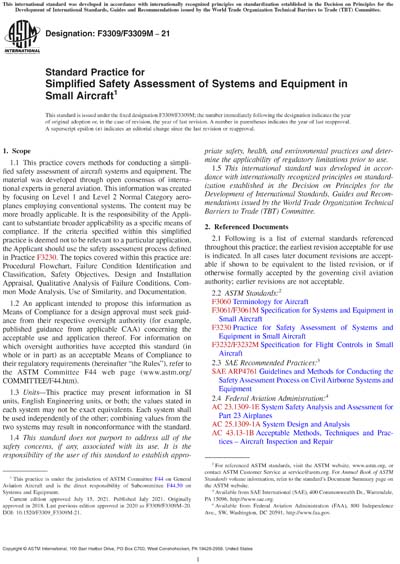Historical
ASTM F3309/F3309M-21
Standard Practice for Simplified Safety Assessment of Systems and Equipment in Small Aircraft
1.1This practice covers methods for conducting a simplified safety assessment of aircraft systems and equipment. The material was developed through open consensus of international experts in general aviation. This information was created by focusing on Level 1 and Level 2 Normal Category aeroplanes employing conventional systems. The content may be more broadly applicable. It is the responsibility of the Applicant to substantiate broader applicability as a specific means of compliance. If the criteria specified within this simplified practice is deemed not to be relevant to a particular application, the Applicant should use the safety assessment process defined in Practice F3230. The topics covered within this practice are: Procedural Flowchart, Failure Condition Identification and Classification, Safety Objectives, Design and Installation Appraisal, Qualitative Analysis of Failure Conditions, Common Mode Analysis, Use of Similarity, and Documentation.
1.2An applicant intended to propose this information as Means of Compliance for a design approval must seek guidance from their respective oversight authority (for example, published guidance from applicable CAA) concerning the acceptable use and application thereof. For information on which oversight authorities have accepted this standard (in whole or in part) as an acceptable Means of Compliance to their regulatory requirements (hereinafter "the Rules"), refer to the ASTM Committee F44 web page (www.astm.org/COMMITTEE/F44.htm).
1.3Units - This practice may present information in SI units, English Engineering units, or both; the values stated in each system may not be exact equivalents. Each system shall be used independently of the other; combining values from the two systems may result in nonconformance with the standard.
1.4This standard does not purport to address all of the safety concerns, if any, associated with its use. It is the responsibility of the user of this standard to establish appropriate safety, health, and environmental practices and determine the applicability of regulatory limitations prior to use.
1.5This international standard was developed in accordance with internationally recognized principles on standardization established in the Decision on Principles for the Development of International Standards, Guides and Recommendations issued by the World Trade Organization Technical Barriers to Trade (TBT) Committee.
Content Provider
ASTM International [astm]






